The Microsoft Lumia 640 Review
by Brandon Chester on June 9, 2015 8:00 AM EST- Posted in
- Smartphones
- Microsoft
- Mobile
- Lumia
- windows phone 8
System Performance
Since the state of benchmarking on Windows Phone is not as mature as Android, I haven’t been able to compare the Lumia 640 to the competition in every aspect that I would like to. What I have been able to do is put it through our standard browser benchmarks, along with BaseMark OS II to look at individual component performance, and GFXBench to examine GPU performance.
While the absolute performance of Snapdragon 400 is well known, certain aspects of performance are heavily impacted by a device’s software. A good example is browser performance, which is a function of both SoC power and the speed of a device’s browser and Javascript engine. Two devices with the same SoC can have very different browser performance.
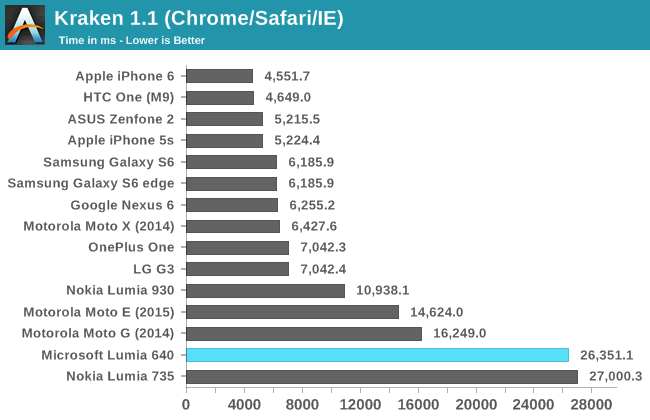
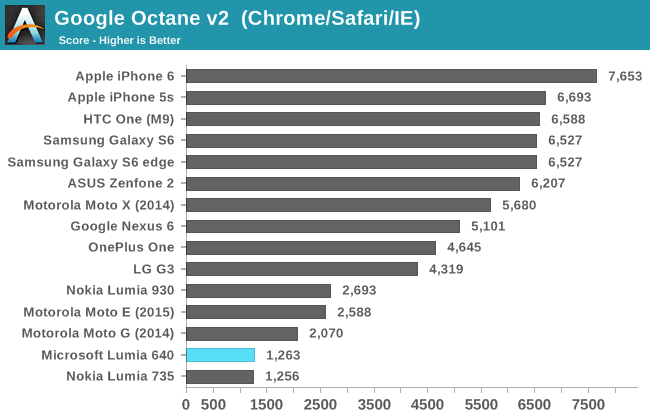
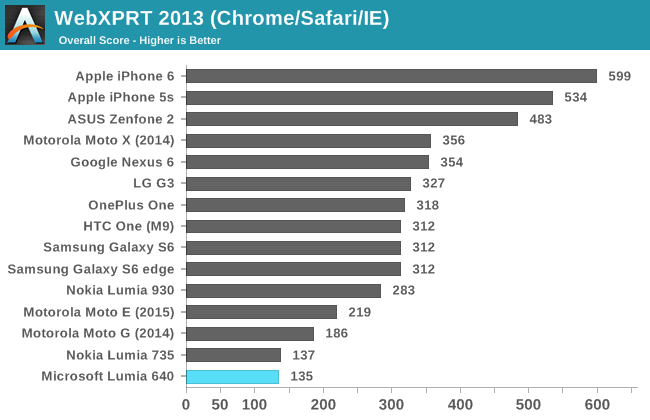
Unfortunately, it’s clear that Internet Explorer doesn’t measure up to Chrome and Safari when it comes to performance. While buyers may be pleased that their Lumia 640 performs as well as the more expensive Lumia 735, both of these phones occupy the lowest positions on every chart. There’s even a significant gap between them and other Snapdragon 400 devices running Android, such as Motorola’s Moto G.
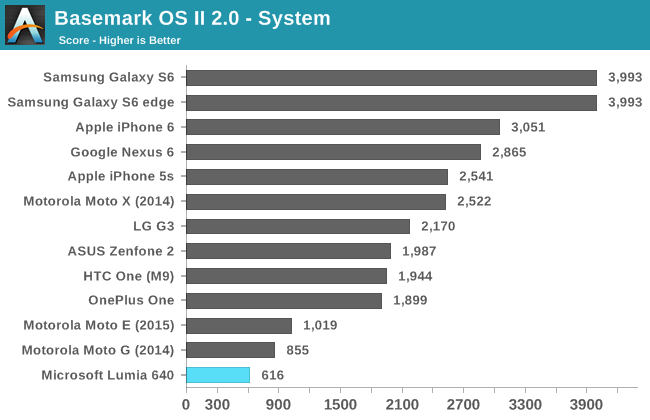
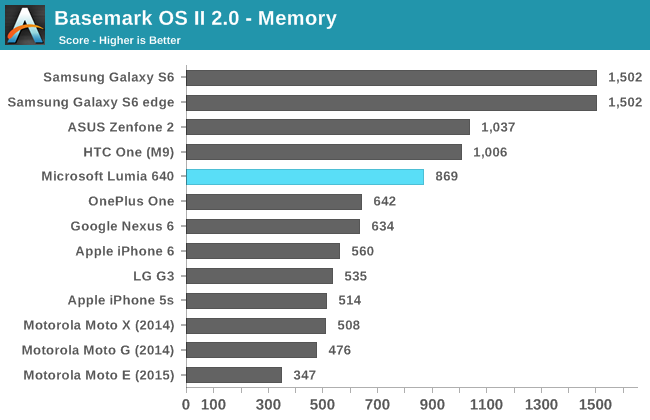


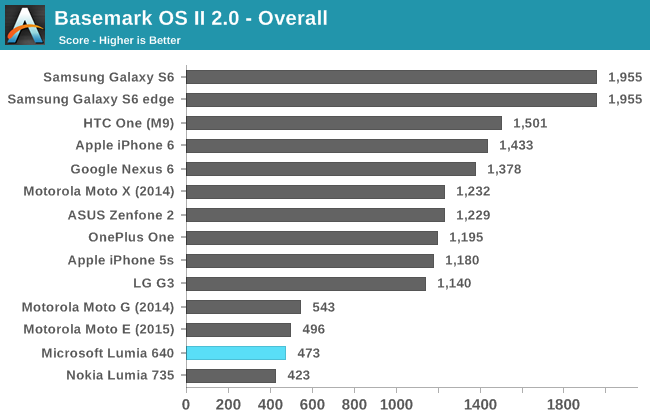
There's not much need to go into detail on the Lumia 640's performance in BaseMark OS II. With the exception of a fairly good result in the NAND memory test, the Lumia 640 achieves the lowest scores that we've seen in recent times.
Unfortunately, the Lumia 640 isn't shaping up to be a very quick device. It's consistently bested by Snapdragon 400 devices running Android, and in 2015 we're going to see Snapdragon 410 used as the SoC of choice in devices at this price bracket, which won't make the Lumia 640's position any better. Microsoft needs to iterate much quicker than they currently are. Their slow pace in adoption new hardware helped kill Windows Phone in the high end market, and it will do the same to the low end. I have some further words about performance on the Lumia 640 and Windows Phone in general, but those will have to wait until the software section of the review.
GPU Performance
The last area of performance to investigate is GPU performance. The performance of Adreno 305 has been thoroughly evaluated on Android, but differences in drivers and graphics APIs can improve or reduce performance across different operating systems.
Since Adreno 305 doesn’t support Direct3D feature level 10.0 and Shader Model 4.0 it’s unable to run the GFXBench 3.0 Manhattan test. This leaves us with only the T-Rex HD benchmark which isn’t very hard on high end devices, but still poses quite a challenge for weaker mobile GPUs.
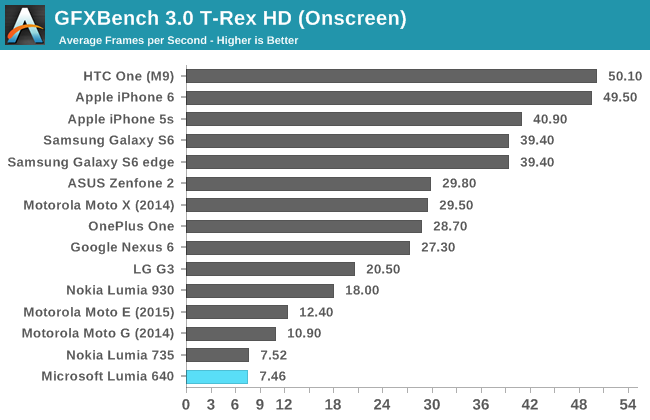
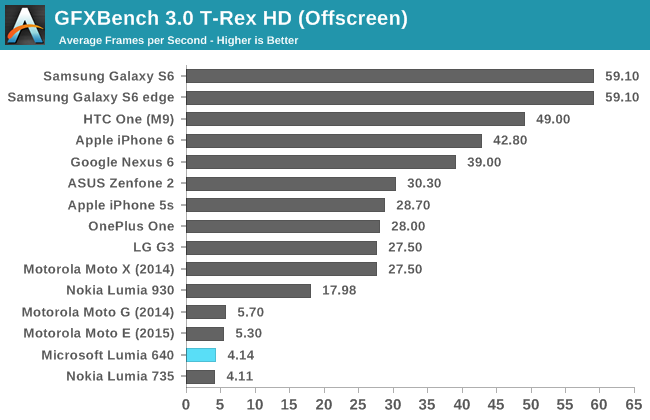
In both the on-screen and off-screen tests, the Lumia 640 lags behind the Moto G. While 1-2fps doesn’t seem like much, when your frame rate is in the low single digits it represents a significant difference in performance. Because of this, I decided to take a look at the performance in GFXBench’s driver overhead test to see what impact the GPU drivers and graphics API might have on performance.
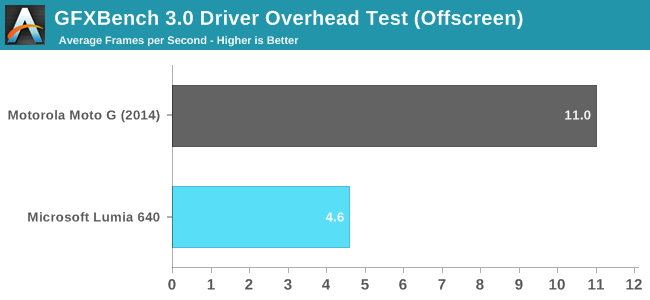
As suspected, there’s a very significant gap in performance when comparing the Lumia 640 to the Moto G. I can’t say whether this is due more to the differences between OpenGL and DirectX, or between the different Adreno drivers on Windows Phone and Android, but whatever the case may be the end result is a notable decrease in GPU performance on Windows Phone when compared to an Android device with the same SoC.
I’m not happy at all with the GPU performance that we see in low-end and even mid-range smartphones, and the Lumia 640 is no exception. There’s not much Microsoft can do here though, as moving to Snapdragon 410 with its Adreno 306 will not improve GPU performance at all. All I can really say is that users shouldn’t expect to be playing any 3D games on their Lumia 640, but simpler 2D games should run just fine.










130 Comments
View All Comments
eanazag - Tuesday, June 9, 2015 - link
I hated Symbian. Buh-bye Symbian.Callum S - Tuesday, June 9, 2015 - link
Nice review. I definitely think that it is a fantastic phone for its price.I can see how the apps situation for some would be a pretty big concern. As mentioned it is mainly Google and local apps that are missed. However at the same time, for those using Microsoft services, I have found it to be significantly better than Android. Exchange, OneDrive, OneNote and MS Office Apps all work beautifully and the ability to pin the live tiles for each to the home screen has saved myself tonnes of time.
That blue glossy case - yep, I would probably want to pass on that too. The matte black version is however also available and in my opinion much better.
I am not too sure about the performance though - especially at the price bracket. After breaking a Nokia 930 I tried to use an old HTC One M7 for a while, before finally buying a Lumia 640, and found the performance of that to be horrible after updating. However perhaps that was due to the HTC sense customisations or something?
My original intention was to use the Lumia 640 until the Lumia 940 with Windows Mobile 10 is released however I am not too sure I'll be able to justify the upgrade now...
Callum S - Tuesday, June 9, 2015 - link
*HTC Sense customisationsWolfpup - Tuesday, June 9, 2015 - link
The HTC stuff may not help, but from my experience Android is just dog slow. I've got a Surface 1 running (almost) real Windows 8, and it runs circles around faster ARM hardware running Android, which is just laughable considering how much better Windows is than Android.Presumably Windows Phone has even lighter system requirements, so... Although who knows about that, given real Windows is probably optimized out the wazoo, while Windows Phone doesn't get as much attention, but still, my Windows Phones all feel fine, while my android stuff running on anything less than the highest end hardware feels slow.
testbug00 - Tuesday, June 9, 2015 - link
Android runs fine when you don't skin it. Moto G/E use A7 quad cores. I believe the original Moto E used a dual core even.And, based on crash reports I've seen, Windows Phone seems to use under 125MB of RAM for the OS.
Daniel Egger - Tuesday, June 9, 2015 - link
Nope, Moto E (2nd gen) runs 4xA53 not A7. Also not to be underestimated the Moto E has a lower screen resolution.mkozakewich - Tuesday, June 9, 2015 - link
In my experience, a proper operating system like Windows or OS X runs a lot faster than some generic, unoptimised version of Linux. I had a netbook with a quick-boot Linux thing, and I could actually turn off my backlight completely when I used it, but my battery would actually drain quicker than when I'd have the screen on in Windows.leexgx - Thursday, June 11, 2015 - link
unlike Android it's a requirement that all apps use GPU acceleration under normal use on windows even on old/new crappy 512mb windows phones run Very consistently (more like IOS iPhone/iPad) with Android your having to use Brute force with faster Flash and CPU (android is only been optimised now in 5.0)testbug00 - Tuesday, June 9, 2015 - link
probably HTC stuff. I have a Moto G (whatever year the original was released in) and it runs Android smoothly. It's a lot weaker than the M7 ;)WorldWithoutMadness - Tuesday, June 9, 2015 - link
Cmon microsoft, just give us sneak preview of 940 already. I'm sick of this badly chosen hardware budget phone.It's not even good enough in super saturated budget phone market in developing country.